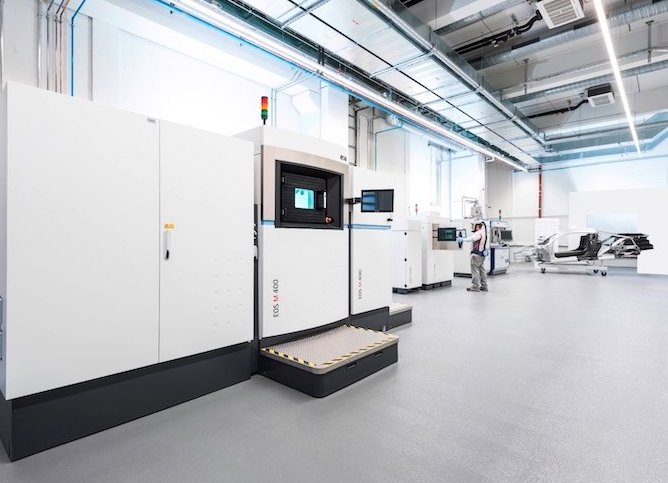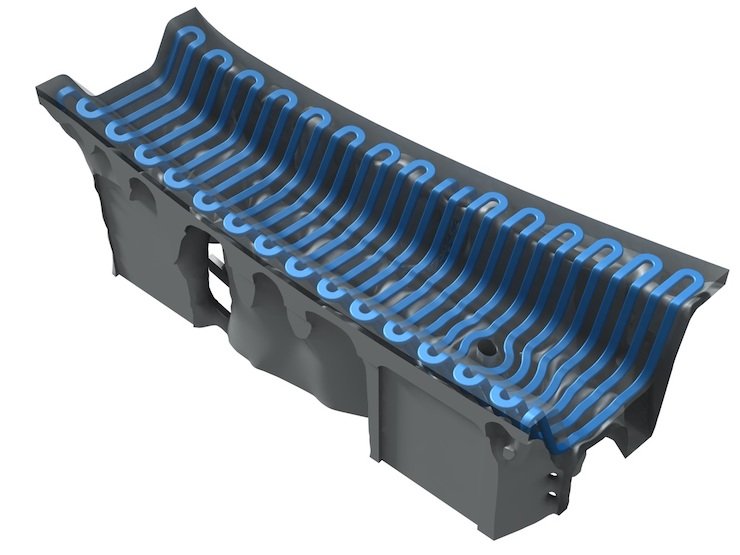German automobile manufacturer Audi has begun to use fully-additive manufactured hot form tooling at its Metal 3D Printing Centre in Ingolstadt.
By expanding its use of EOS 3D printing, Audi is now able to produce twelve different segments of four hot forming tools at the facility, which are later used to assemble car models such as the A4 saloon. The company’s move reflects its increased confidence in the reliability and quality of additive manufactured parts, and in future, it plans to utilize the technology to build its electric vehicles as well.
“The latest examples show that 3D printing has become an established part of operating materials production at Audi,” said Markus Glasser, Senior Vice President EMEA at EOS. “Audi is a partner we can work with to continue to drive the use of AM in automotive production – a key industry for us.”
“We’re especially proud that the tool segments made using AM are created exclusively using an industrial 3D printer from EOS.”

Audi’s 3D printing integration
Like many of its automotive rivals, Audi has utilized 3D printing within its production workflow for much longer than it has publically discussed. In 2015 it began to reveal the extent of its capabilities, using the technology to reproduce its 1936 Auto Union Type C Car. In the years since, the company has widened its application of the technology, and it acquired an SLM Solutions system for prototyping and creating components on-demand in 2018.
Audi followed this up by installing a Stratasys J750 system at its design center in Ingolstadt, using it to prototype tail light covers and accelerate design verification. On the tooling front, Audi has also found working closely with EOS to be particularly beneficial, and the companies’ engineers have been co-developing automotive 3D printed tooling applications for the last four years.
In that time, Audi has expanded production at its Volkswagen Böllinger Höfe facility, opening a separate 3D printing department with the aim of expediting its tool production. The new area includes four Ultimaker and MakerBot systems, which are specifically tasked with producing auxiliary tools for guiding machinery, as well as casting molds and safety devices.
With its latest application of 3D printing, Audi has now started to fully-print hot form tooling for use within its vehicle assembly process. While the carmaker has utilized EOS’ technology at its Ingolstadt facility since at least 2017, the move still represents a significant milestone, and a glimpse into its growing 3D printing capabilities.

Accelerating AM at Ingolstadt
At its Ingolstadt plant, Audi has essentially ditched conventional manufacturing in favour of 3D printing, when it comes to producing hot forming segments and high-pressure die casting tool inserts. Using EOS’ M400 3D printer, engineers at the facility’s design department are now able to create entire tools measuring up to 5m x 3m in area, or segments weighing up to a hefty 120kg.
Given the size and complexity of the tooling produced, the process can take as long as 20 days, meaning that the reliability of EOS’ machine has been crucial to the technology’s integration. What’s more, using 3D printing, Audi’s crew has been able to create tooling with highly-complex cooling channels, reducing their lead times in the process.
At present, the new tooling is being utilized within Audi’s press shop, to help make body panels for cars such as its A4 saloon. Several hundred thousand parts have already been produced using the tools, and installed on selected models, and the company has now made it clear that it intends to take a similar approach to building its electric vehicles in future.
“We are now reaping the fruits of years of development within Audi’s production organization,” said Matthias Herker, Technical Project Manager at Audi’s Metal 3D Printing Centre. “Whenever conventional manufacturing methods reach their limit, we use additive manufacturing, which lets us meet quality standards and comply with production times.”
Advances in automotive AM
Automotive firms such as Ford have utilized additive manufacturing for prototyping since the commercial launch of the very first 3D printers, and it acquired one of the first 3D Systems SLA 3D printers produced in the 1980s. In subsequent years, advances in 3D printing has increasingly enabled carmakers to create jigs, fixtures, tooling, and more recently, low volumes of specialized parts on-demand.
In January 2021, for instance, product design firm CALLUM used MakerBot’s METHOD X 3D printer to create components for a limited edition Aston Martin. Adopting the system enabled the design company to manufacture prototypes, tooling, and spare parts for R-Reforged’s one-off reimagining in-house with reduced lead times.
On a similar note, Porsche worked with TRUMPF and MAHLE in July 2020, to 3D print optimized pistons for the engine of its 911 supercar. Using an AI-led additive manufacturing process, the automotive firm was able to reduce the pistons’ weight by 10%, and add 30 BHP to the engine’s horsepower.
Elsewhere, Groupe Renault has sought to integrate 3D printing into its upcoming sustainable automotive ‘Re-Factory.’ Although the facility will primarily focus on reducing waste by recycling and retrofitting vehicles, it will also house a a dedicated spare parts additive manufacturing service.
To stay up to date with the latest 3D printing news, don’t forget to subscribe to the 3D Printing Industry newsletter or follow us on Twitter or liking our page on Facebook.
Are you looking for a job in the additive manufacturing industry? Visit 3D Printing Jobs for a selection of roles in the industry.
Featured image shows Audi’s TechDay Smart Factory. Photo via EOS.



